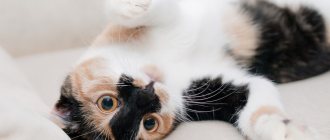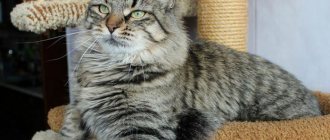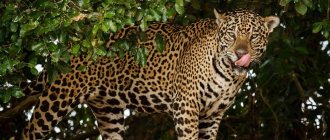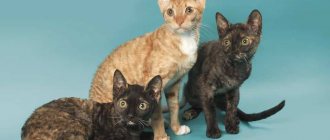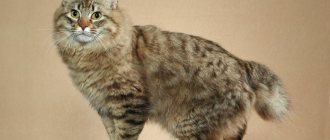The feline family is not only about cute furry animals that purr and rub against their owner's legs. Even domestic cats can reach speeds of up to 40 km/h over short distances, and wild cats are among the fastest animals on the planet. Moreover, if we consider that they are all predators, this means they are also among the most dangerous.
Dune cat
The sand cat is the smallest representative of wild cats, and therefore is often endangered by other predators. Capable of chasing prey at a speed of 40 km/h for 10 km.
Egyptian Mau
Although the Egyptian Mau has long been domesticated, the wild nature of the cat still takes over. From the time when her ancestors had to hunt for survival, Mau learned to run at a speed of 58 km/h.
Leopard
For him, high speed is not particularly important, since he does not hunt on the ground. This spotted wild cat prefers to watch for prey, hiding in the foliage of trees, and overtake it with one sharp jump. He has strong muscular legs, and his running speed can reach 60 km/h.
Tiger
A very large cat, capable of chasing prey at speeds of 60 km/h. But a weight of more than 300 kg and a 3-meter body length often interfere with successful hunting.
Puma
Like the lion, its close relative is large in size, but is capable of maintaining a speed of 75 km/h. This gives the puma an advantage during hunting, but its large dimensions do not allow it to maintain speed for a long time.
Snow Leopard
The handsome snow leopard can only be found high in the mountains. He not only runs fast, but also jumps. The length of his jump can be 6 meters and the height - 3 meters. In terms of running speed, the leopard is not inferior to the lion, while the animal’s long tail acts as a steering wheel and helps to turn in different directions.
a lion
The king of beasts is a fairly large animal with a body weight of more than 2 centners. Therefore, it is difficult for him to maintain high speed over long distances. At a speed of about 80 km/hour, a lion can run no more than 20 meters. When hunting, this predator prefers to lie in wait for its prey and pounce on it.
Panther
The panther is not only fast, but also the most dexterous and dangerous predator.
This wild cat is unusually graceful and, unlike its counterparts, hunts near human settlements. The black beauty is capable of running at a speed of 88 km/h and is particularly bloodthirsty. The objects of her hunt can be not only animals, but also humans.
Jaguar
This animal can move at a speed of 90 km/hour. Jaguars are large. The body, without a tail, can reach a length of more than 2 meters. Because of their size, it is quite difficult for them to pursue prey at high speed for a long time.
Cheetah
Considered the fastest animal on Earth. A wild cat has a powerful, muscular body without an ounce of excess fat. The weight of a cheetah is 70 kg, and the speed that the animal develops exceeds 110 km/h.
The predator will not sit in ambush and guard the prey. The cheetah needs a few tugs and the prey will be in its claws. Just two seconds are enough for this “savage” to develop lightning speed, and the length of the jump can reach 8 meters.
Siamese cat
Siamese cats are playful, active, sometimes noisy and quite demanding. Their cheerful intelligence allows them to do many complex things, such as turning on faucets, switching lights, and opening cabinets. To keep her entertained, you'll have to give her puzzle toys, exercise, and maybe even agility training.
The cat limps while running
In a situation where the animal limps when running and tries not to lean on one of its paws, one can suspect that the pet has a musculoskeletal disease. For example, a cat could accidentally get a bruised paw or a muscle strain; even the most dexterous pets are not immune from this.
If the lameness does not go away after a couple of days, the animal may face more serious health problems. With severe swelling and pain, a joint dislocation or limb fracture is possible. An X-ray examination and consultation with an experienced veterinarian will help establish the diagnosis.
Egyptian Mau
The fastest representatives of domestic cats are considered to be the Egyptian Mau (“Mau” means cat). The maximum record of these miniature darlings is acceleration to 58 km/h (over short distances). All zoologists claim that if these animals had larger dimensions, they could well compete with the cheetah for the title of the fastest animal on the planet.
Fourth place – Leo
The Lion King of Beasts amazes with its grace and power. He is capable of running at a speed of 82 km/h over a distance of 20 meters. For the next 100 meters, the predator can maintain a pace of up to 60 km/h. The animal is heavy - everything reaches 250 kg. Lions are interested in immediately grabbing prey, because it is difficult for them to run for a long time at a fast pace.
The fastest breeds of domestic cats
Most domestic cats run faster than humans. Some of them are capable of reaching speeds of up to 45 km/h.
Most often, running speed depends on the body features inherent in a particular breed. Fast domestic cat breeds include:
Oriental
The Oriental is an elegant cat breed devoted to one person. To be completely happy, they need races, physical exercise and active games. If an Oriental is kept indoors, it will have fun making a mess.
Siamese cat
The Siamese cat is always active and can make too much noise. Her restless temperament allows her to play pranks in several places at the same time.
It is important for the owner to know that Siamese dogs benefit from physical exercises for speed and agility.
Manx
Manx is one of the most ancient breeds. They differ from their counterparts by having a short or completely absent tail. Cats of this breed show excellent results in agility and speed.
Ocicat
The Ocicat is a muscular descendant of Abyssinians, Siamese and American Shorthairs. In addition to his athletic build, he is known for his speed and agility. Cats of this breed are very sociable and attached to their owner.
Savannah
Savannah is a close relative of the wild serval. Cats of this breed are very smart, curious and energetic. From their wild ancestors they inherited the ability not only to run fast, but also to climb to great heights.
Bengal
Bengal will never get bored and will not let its owner do so. An extremely active breed, and also a keen climber. If your Bengal cat is out of sight, you should pay attention to the top of the room. She will definitely be there.
Somali cat
The Somali cat is a long-haired version of the Abyssinian. It has a muscular body and well-developed limbs. Shows high ability to train and perform tricks.
Features of character and lifestyle
Photo: Wild puma
Since cougars are individualists by nature, each individual occupies quite large domains. Predators mark the boundaries of their territory with urine, feces and notches in trees. The territories of opposite-sex individuals can overlap, but males never enter each other’s territories if they feel that the domain has an owner.
It happens that wild cats have to change their environment due to circumstances. They will try to leave foreign areas as quickly as possible and occupy a free zone. The road can be long. So, pumas from Wyoming were met in Colorado, which is half a thousand kilometers away.
Mountain lions are very patient and silent animals. If the tiger goes on a rampage in the trap trying to free itself, the cougar will calmly get rid of the trap, even if it takes several days. If she fails to break free from the shackles, she will fall into melancholy and lie silently and motionless.
Cougars do not attack people and try to avoid them in every possible way. It’s not for nothing that modesty is considered one of their character traits. The cougar will not show aggression until it becomes so hungry that it is on the verge of exhaustion or tries to protect its offspring.
Interesting fact: North American Indians believed that cougars were creatures of the devil. Their roar made everyone shake with fear. But these cats make the sound of a locomotive whistle only when they are angry; the rest of the time they purr like cats.
Tiger
The tiger has also long been on the list of the fastest representatives among predatory cats. At short distances, it is capable of reaching speeds of up to 60 km/h. Just imagine that in pursuit of a victim they will be able to jump 5-6 meters in length (and in height, by the way, too).
But, even despite these physical abilities, not every tiger hunt is successful. These cats are very massive, their weight can increase up to 300 kg, and their body length (excluding the tail) can vary up to three meters. That is why, despite their physical dominance, they are significantly inferior to the cheetah in speed.
The fastest bird is the peregrine falcon (Falco peregrinus)
This bird of prey from the falcon family can be seen on almost all continents, with the exception of Antarctica.
In nature, there are about 17 subspecies of peregrine falcons.
On our planet it is not only the fastest bird, but also the fastest living creature.
© Fernando Cortes
According to experts, in a fast diving flight, a peregrine falcon can reach speeds of up to 322 km/h.
But it is worth noting that in horizontal flight the peregrine falcon yields first place to the swift, whose horizontal flight speed can reach 111 km/h.
Sixth place – Puma
The predator runs very quickly over short distances. The animal is capable of reaching speeds of up to 75 km/h. That is, a cougar can even catch up with a car that is not going too fast.
In the United States of America, the cougar is commonly called the “mountain lion.” The name is associated with the animal's habitat. The predator can be found not only in forests, but also in the mountains. Moreover, the puma is found even in the jungle and swamps.
Differs in large sizes. Together with the tail, the body reaches 2 meters in length. At the same time, the weight is not too large - from 50 to 100 kg. Much depends on gender and individual characteristics. Due to its well-developed muscles and light weight, the Puma is able to run quickly and hunt deftly.
Description of appearance
Jaguars belong to a species of predatory mammals of the cat family. These animals are the largest predators living on the American continent. Among the largest representatives of predatory animals they occupy an honorable third place.
The body of some animals can reach a length of 2 meters. Such specimens are found in the jungles of Brazil. The average weight of a jaguar is 80-90 kg, but there are animals whose weight exceeds 100 kg. Outwardly, they are very similar to leopards, but much larger in size. Males are larger in weight and size than females.
The height at the withers of the predator reaches 80 cm, and the length of the tail is 50-80 cm. This strong, large and agile animal has a smooth-haired skin. The fur is short and the head has rounded ears. The structure of the skull is very similar to tigers. The color of the animal can be very diverse. Typically, the coat color is dominated by shades of rich red and sandy tones. The lower part of the body and soles are white. The entire body is decorated with dark spots.
These cats have well-developed all senses:
- amazing hearing;
- sharp vision.
The jaguar's whiskers are the main organ of touch. Thanks to this, the animal moves almost silently at night in the jungle.
The black jaguar is also common in nature. In appearance, this cat is one of the most beautiful in this family. The weight of a black jaguar can reach 120 kg, and the length of its tail is up to 1 meter. It fascinates with its beauty, so local residents believe that the black jaguar is endowed with hypnosis. These jaguar cats are often confused with panthers. They prefer wild spaces. The panther jaguar loves to live in tropical forests.
Savannah
The Savannah is a cross between a domestic cat and a Serval, a medium-sized African cat with large ears. Savannah will climb as high as she can, and her long body and legs allow her to reach not only great heights, but also great speeds. The breed is also known for its curiosity, keen intelligence and energy.
Why do cats run around like crazy?
You may notice that your cat gets sudden bursts of energy and runs around the house at full speed. This is also called "zoom".
Cats are ambush predators and spend most of the day resting to conserve their energy. Domestic cats don't hunt much, so these zombies are their way of releasing pent-up energy.
If your cat likes to run around like this at night, tire her out during the day by playing with her. This will encourage them to just curl up at night instead of causing a fuss.
Another reason your cat runs around the house is because of other animals. If your cat is running around the house at night, she may have found rats or mice and is stalking or stalking them. If your cat is running from one window to another, they will likely see an animal outside, such as a raccoon or a squirrel.
Puma
The puma (or mountain lion) consistently occupies sixth position in the world top of the fastest cats. These predators reach speeds of up to 75 km/h over short distances.
These large animals reach two meters in length (including tail). The weight of these cats reaches 100 kg. A well-developed muscular system and low weight contribute to the speed and agility of mountain lions. They can accelerate to 75 km/h.
Females are smaller in size than males. But, at the same time, they are not inferior to them in agility and speed.
Liger
The result of the love between the tigress Isla and the lion Arthur, who shared a common enclosure at the American theme park Jungle Island, became a kitten, which was later destined to top the ranking of the largest cats on the planet. Having reached maturity, the liger Hercules surpassed his parents in size. His height is 186 cm, weight - 410 kg. Standing on his hind legs, the giant reaches the roof of a double-decker bus. The gaping mouth is as wide as the shoulder girdle of an adult man.
Hercules is not the only representative of the hybrid genus. In 1973, the Guinness Book of Records added a record of a giant weighing 798 kg from a South African nature park. In 2004, a female was born at the Novosibirsk Zoo - the result of crossing an African lion and a Bengal tigress. It is impossible to meet a liger in natural conditions - tigers and lions have different habitats.
Bengal cat
Bengals love to play and enjoy any activity. They are also very demanding of your attention and will do whatever it takes to get it. Your Bengal will easily find a way to climb to the highest point in your house, he will enjoy games and activities, and he will definitely not sit on your lap all day.
Gentle, purring creatures. How to choose just such a cat
In fact, the secret is simple: the most affectionate cats only come from loving owners. If you give an animal your tenderness and care day after day, then it will answer you in kind. Cats are quite vindictive; once strongly offended, she will look at you for a long time before she believes you again. Do you want the most gentle and kind creature in the world? Take a cat from the street. Devoted, she will forever remain grateful for her salvation.
If you choose a purebred pet, then the most affectionate cats are Russian Blue, Sphynx, Burmese, Cornish Rex. We must make allowances for the fact that each breed has individual personalities with their own character. Love your pet for who he is.
Often the opposite question arises, so to speak: “Which cats are the most aggressive and evil?” Indeed, there is something to think about. Just imagine: proud posture, mysterious look, demonstrative independence, and if something goes wrong, then fangs and claws are used! And if there is a small child at home, the question becomes very acute. These breeds include the magnificent Siamese. Amazing coloring and wonderful blue eyes are often decisive when choosing a kitten. But these “princes” and “princesses” are very freedom-loving, they will come into their arms only when they want, and will never allow themselves to be dragged by the tail!
Moderately aggressive dogs include Maine Coons and Britons. It is quite possible to come to an agreement with them, if you are not too familiar.
The fastest cats in the world
Wild cats are fast and agile animals that are excellent hunters. Even a domestic cat can run at a speed of 40 km per hour. The pet will not be able to cover a long distance at this pace. He will be able to make a tiny leap. Wild cats have greater endurance, so they are able to run at high speed for much longer.
When measuring indicators, the distance and time it takes the animal to cover the distance are taken into account. There are many cats in nature that are capable of running with incredibly high agility.
Captivity
The puma is perhaps one of the few species of wild cats that is still quite numerous, despite the fact that they are still hunted and their natural habitats are gradually being reduced.
The Cougar's strength lies in its incredible ability to adapt to new living conditions and survive. Thus, the population of Mountain Lions in North America (western regions), practically exterminated at the end of the last century, now numbers more than thirty thousand individuals, continues to multiply and spread to the southern and eastern territories.
However, some subspecies have already been wiped out from the face of the planet, while others are on the verge of extinction and are listed in the International Red Book and the first appendix of the CITES Wildlife Trade Conventions. These are Puma concolor coryi, Puma concolor costaricensis, Puma concolor couguar. Hunting and selling of these Pumas is prohibited, although partial shooting due to attacks on livestock is sometimes necessary.
Another subspecies of Cougar - the Florida Puma Puma concolor coryi, which we have already written about, is simply in a critical state in terms of population size; it is listed in the Red Book with the status “critically endangered”. During the reign of Theodore Roosevelt, numerous societies for the protection and protection of animals were created, but these measures did not apply to Pumas. As the main eaters of livestock, they continued to be exterminated. In some ways, these measures are justified, because there are a lot of attacks on people.
It should be remembered that in areas where Pumas live, the following precautions should be carefully observed:
- Do not let children go and keep a close eye on them, as Cougars most often attack them or short adults, avoiding contact with tall, strong men.
- When moving through the forest, have at least a strong stick in your hands.
- Do not hike alone here.
- Do not move during twilight and night hours.
- Always light fires at camp sites and do not leave them alone and without weapons.
- When attacked by an animal, do not run away under any circumstances. You need to look straight into the eyes of the predator and “howl.” Sometimes this method scares away the beast.
Nowadays, numerous national parks and reserves have been created in both Americas to increase the number of Cougar populations.
These wild cats get along well in captivity and bear offspring well; many of them live in zoos in different countries. In recent years, interest in Pumas has increased as potential pets.
It should be remembered that at a young age, Puma kittens are really cute and seem harmless. As the animal grows older, the wild, predatory nature can absorb all its affections. A strong adult animal should be kept only in an enclosure and handled with caution; it cannot be tamed.
Nevertheless, there are breeders of these animals. An animal can be purchased at a price from 5 to 20 thousand dollars.
The fastest cats
What helps the fastest cats run
Among purebred cats, the Egyptian Mau is considered the record holder for speed. He was lucky with the structure of his hind legs, which have leathery folds at the base. Due to them, while running, the step reserve and amplitude of movements increase, and therefore the speed increases.
The normal speed of cats (on average) is 13.5-13.8 km/h. If a cat moves at a leisurely trot, then it will barely overtake a walking person, and its speed will be about 8 km/h. Whereas the maximum speed of cats is 50 km/h.
Reproduction of predators
Female cheetahs lead a solitary lifestyle, with the exception of periods spent with cubs. Male predators usually live together in groups of several individuals. They constantly fight for territory and the females that live on it. A pair of males usually maintains territorial positions for about six months. If three males live together, then the territory can remain theirs for up to 2 or more years.
After the female begins to ovulate, the cheetah stalks her for some time before mating. The gestation period lasts about 90 days, and females give birth to 2 to 6 cubs. The first time after birth, kittens are completely helpless, which makes them easy prey for other predators. Feeding with mother's milk lasts up to eight months of age, and the cubs live with their mother for up to 12-20 months. The further existence of the animal implies independent satisfaction of all vital needs.
Snow Leopard
This top is completed by the snow leopard. They are capable of jumping over a distance of 6-7 meters (the height of the jump reaches 3 meters). The leopard has short, but muscular and strong legs and a fairly long tail, which is necessary to maintain balance during a sprint. By the way, the maximum speed of this representative of the cat family can reach 80 km/h. The snow leopard is the highest mountain animal among all the inhabitants on the planet.
The first position in the ranking is still occupied by the cheetah. This spotted hunter is capable of reaching a speed of 112 km/h. in just 3 seconds. The maximum speed reaches 130 km/h. The length of one jump of this predatory cat can reach 7-8 meters. In addition, the cheetah is able to change the trajectory of its movement almost at lightning speed. That is why the victim has virtually no chance to escape the attack.
- Author: iarriba
Rate this article:
- 5
- 4
- 3
- 2
- 1
(36 votes, average: 3.9 out of 5)
Share with your friends!
Leo – honorable third place
The third place in speed is occupied by the king of beasts - the lion. He is capable of reaching speeds of up to 80 km/h, but, like most record-breaking cats, he runs only short distances and rests for a long time after the race.
Lions are interesting not only because of their sprinting abilities. Firstly, it is the largest animal from the cat family. Secondly, lions have pronounced sexual dimorphism - who doesn’t know about the luxurious mane of male lions! Thirdly, the social organization of lions is of interest. Most often they live in prides, where there are 1-2 males for every 5–6 lionesses. Lions expelled from a pride live in pairs or alone. Their status may change - males join the pride or leave it.
The lions' habitat has declined significantly in recent centuries. In Africa they live mainly in savannas. A small population remains in India.
MegaMix
Domestic cats run somewhat slower than homeless cats, for whom speed and lightning speed of reaction are a way of survival. But even at home, they need active movement, so even without visible danger, the cat likes to stretch its muscles, rushing from room to room. In such games, she seems to be chasing imaginary prey. The average speed of the animal, regardless of its habitat, is 13.86 m/s. Even the most unprepared cat runs much faster than a human thanks to a special running technique.
Maximum and average speed
| average speed | Maximum speed | |
| 13.86 m/s | 50 km/h | up to 58 km/h (home) |
In case of danger, she lunges, arches her back and makes jumps that exceed the length of her own body up to 6 times. The front and hind legs work in pairs. When jerking, the animal pushes off the surface with its hind legs, landing first on the front, then on the back pair of legs. When walking leisurely, a cat steps on the pads, but when running, the cat's claws extend outward, which provides better traction on the surface for effective pushing.
Features of running cats and cats of different breeds
Maine Coon cats use their fluffy tail, which has strong muscles at the base, to regulate speed. The bobtail cat breed cannot boast of a powerful tail, as this limb is practically absent. They develop high speed thanks to their high and strong hind legs. This variety is considered one of the most energetic cat breeds; the bobtail needs long active games and requires an equally active lifestyle of the owner.
The leader in terms of speed among domestic cats is the Egyptian Mau breed. At the base of their hind legs they have folds of skin in the form of small bags. The resulting step reserve allows the cat to have a particularly wide range of motion when running and, therefore, to run faster than its relatives from other breeds.
The cat is the victim, the cat is the hunter
Since cats do not occupy a dominant position in the food chain, in the wild they often find themselves in the role of prey and her life depends on how quickly she manages to escape. In its own hunt, this small predator usually focuses on surprise and dexterity of the paws, rather than speed. Having previously hidden and accurately calculated its death-carrying throw, a cat is able to catch a mouse or bird even in flight.
Speed is an advantage, but not an option
However, with all its sprinting qualities, which allow the cat to reach speeds of up to 50 km/h, the cat’s heart is not able to withstand prolonged stress. After a long run at high speed, the cat is forced to stop to normalize its body temperature and breathing. Therefore, when the pursuit is too long, the animal will have to give up. A cat driven by a pack of dogs is doomed to death if it has nowhere to hide.
In urban conditions, where there is not always a suitable tree to climb and avoid danger, these animals die more often than in rural areas.
Puberty and reproduction
The mating season is not tied to any specific time of the year, but in the northern regions it still often occurs in December-March.
Females breed for 9-10 days. Males at this moment fight among themselves for the attention of women and try to mate all the individuals located on their territory.
The female bears the cubs for a long time, like big wild cats - from 85 to 98 days. Babies are born blind and completely helpless, they weigh 300-500 g and are about 25-30 cm in length. There are from one to six kittens in a litter. The color at birth is very dark with charcoal markings; it begins to change only at one year of age. The coat is much thicker, there are ring stripes on the paws and tails. When the eyes open, about two weeks after birth, they are bright blue, changing to green or yellow only at six months.
Up to one and a half months, the babies only suckle their mother, then they begin to leave the den, try solid food, and play actively.
Until one and a half to two years old, young Pumas live next to their mother, learning from her the science of hunting and survival in the wild. Closer to the mating season, the children leave, until the first rut they hunt together.
Sexual maturity comes to females at 2.5-3 years, to males a little later. Animals do not begin to mate immediately, only after they have found “their” hunting area.
It is easier for young females; they can always settle down close to their mother and count on her help. Young Mountain Lions are forced to fight with experienced males to conquer hunting grounds or travel thousands of kilometers in search of “no man's” lands. It is these animals that most often attack people; they worry about parting with their mother, and are often irritated and hungry.
In their native habitats, Pumas rarely live to be 15 years old, and males die more often. In captivity, the life expectancy of Mountain Lions is much longer - 20-25 years.
